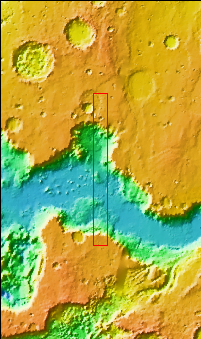
|
Ganges Chasma Landslides - False Color
- Click the image above for a larger view
- Full-Res JPEG (606 x 2710) (96.3 kB)
- Full-Res TIFF (606 x 2710) (2.1 MB)
Caption:

Context image
The THEMIS VIS camera contains 5 filters. The data from different filters can be combined in multiple ways to create a false color image. These false color images may reveal subtle variations of the surface not easily identified in a single band image. Today's false color image shows part of Ganges Chasma. A large landslide deposit fills the bottom third of the image, and another landslide deposit is visible near the top of the image. The radial grooves on the top of a landslide are a common feature formed by the downslope movement of the landslide materials. A field of dunes is visible in the center of the image. Ganges Chasma is part of the Valles Marineris chasma system, but is north of the main section of canyons. Ganges Chasma is 584km (363 miles) long.
Orbit Number: 70657 Latitude: -7.47135 Longitude: 315.505 Instrument: VIS Captured: 2017-11-18 00:19
Background Info:
Please see the THEMIS Data Citation Note for details on crediting THEMIS images.
NASA's Jet Propulsion Laboratory manages the 2001 Mars Odyssey mission for NASA's Science Mission Directorate, Washington, D.C. The Thermal Emission Imaging System (THEMIS) was developed by Arizona State University, Tempe, in collaboration with Raytheon Santa Barbara Remote Sensing. The THEMIS investigation is led by Dr. Philip Christensen at Arizona State University. Lockheed Martin Astronautics, Denver, is the prime contractor for the Odyssey project, and developed and built the orbiter. Mission operations are conducted jointly from Lockheed Martin and from JPL, a division of the California Institute of Technology in Pasadena.
Cataloging Keywords:
| Name | Value | Additional Values |
|---|---|---|
| Target | Mars | |
| System | ||
| Target Type | Planet | |
| Mission | 2001 Mars Odyssey | Mariner |
| Instrument Host | Mars Odyssey | |
| Host Type | Orbiter | Flyby Spacecraft |
| Instrument | Thermal Emission Imaging System (THEMIS) | |
| Detector | ||
| Extra Keywords | Color, Dune, Thermal | |
| Acquisition Date | ||
| Release Date | 2021-03-18 | |
| Date in Caption | 2017-11-18 | |
| Image Credit | NASA/JPL-Caltech/ASU | |
| Source | photojournal.jpl.nasa.gov/catalog/PIA24504 | |
| Identifier | PIA24504 | |
